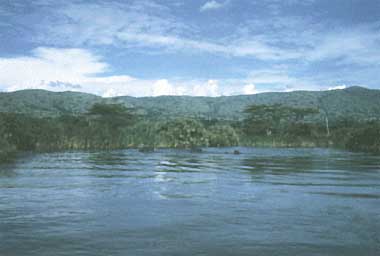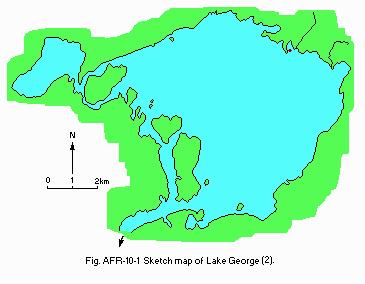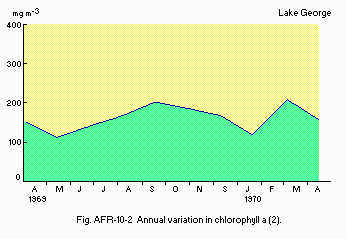LAKE GEORGE
A view on the lake
Photo: M.J.Burgis
A. LOCATION
- Western, Uganda.
- 0:05-0:05S, 30:02-30:18E; 914 m above sea level.
B. DESCRIPTION
-
Lake George lies in the western branch of the Great Rift Valley. It is a small shallow lake of about 250 km2 with an average depth of 2.4 m.
It is supplied by inflows from the Rwenzori mountain range and from the agricultural area towards the northeast; major inflows include Rumi, Mubuku and Nsonge from Rwenzori and Mpanga and Dura from the northeast.
The outflow is the Kazinga Channel which drains toward Lake Edward. The northern lake shore is lined with papyrus swamp. The level of water fluctuates very little.
At an altitude of 914 m above sea level, Lake George has its main catchment area in the Rwenzori range. Apart from the agricultural lands in the northeast, there are no major sources of allochthonous material.
The lake experiences two rainy seasons with rainfall peaks in May and October and the monthly means range from 3 to 194 mm. The lake is highly productive and lucrative fishery goes on. The lake has been fairly well investigated (Q).
C. PHYSICAL DIMENSIONS (Q)
| Surface area [km2] | 250 |
| Volume [km3] | 0.8 |
| Maximum depth [m] | 4.5 |
| Mean depth [m] | 2.4 |
| Water level | Unregulated |
| Normal range of annual water level fluctuation [m] | 0.1 |
| Residence time [yr] | 0.3 |
| Catchment area [km2] | 9,705 |
D. PHYSIOGRAPHIC FEATURES
D1 GEOGRAPHICAL (Q, 2)- Sketch map: Fig. AFR-10-01.
- Names of main islands: Iranqara, Akika and Kankuranga.
- Number of outflowing rivers and channels (name): 1 (Kazinga Channel).
- Climatic data at Kabale (1)
| Mean temp. [deg C] | ||||||||||||
| Minimum | ||||||||||||
| Jan | Feb | Mar | Apr | May | Jun | Jul | Aug | Sep | Oct | Nov | Dec | Ann. |
|---|---|---|---|---|---|---|---|---|---|---|---|---|
| 10 | 10 | 10 | 11 | 11 | 9 | 9 | 10 | 10 | 10 | 10 | 10 | 10 |
| Maximum | ||||||||||||
| Jan | Feb | Mar | Apr | May | Jun | Jul | Aug | Sep | Oct | Nov | Dec | Ann. |
| 24 | 24 | 23 | 23 | 22 | 22 | 23 | 23 | 24 | 23 | 23 | 23 | 23 |
| Precipitation [mm] | ||||||||||||
| Jan | Feb | Mar | Apr | May | Jun | Jul | Aug | Sep | Oct | Nov | Dec | Ann. |
| 61 | 91 | 114 | 136 | 92 | 26 | 20 | 55 | 95 | 98 | 107 | 91 | 986 |
- Number of hours of bright sunshine: 1,981 hr yr-1 (Q).
- Solar radiation: 20.0 MJ m-2 day-1 (Q).

Sketch map of the lake (2).
- Water temperature [deg C](Q)
| 1988 | ||||||||||||
| Depth [m] | Jan | Feb | Mar | Apr | May | Jun | Jul | Aug | Sep | Oct | Nov | Dec |
|---|---|---|---|---|---|---|---|---|---|---|---|---|
| 0 | - | - | - | 29.8 | - | - | - | - | - | - | - | - |
| 0.5 | - | - | - | 28.5 | - | - | - | - | - | - | - | - |
| 1.0 | - | - | - | 26.8 | - | - | - | - | - | - | - | - |
| 1.5 | - | - | - | 26.4 | - | - | - | - | - | - | - | - |
| 2.0 | - | - | - | 27.1 | - | - | - | - | - | - | - | - |
- Freezing period: None (Q).
- Mixing type: Polymictic (Q).
- Notes on water mixing and thermocline formation
Stratified during the day when temperature ranges from 30 to 35deg C, and mixed at night when temperature lowers to 23-27deg C (Q).
E. LAKE WATER QUALITY
E1 TRANSPARENCY [m](3) 0.4. E2 pH (3) 9.3-9.9. E4 DO [mg l-1](Q)| 1988 | ||||||||||||
| Depth [m] | Jan | Feb | Mar | Apr | May | Jun | Jul | Aug | Sep | Oct | Nov | Dec |
|---|---|---|---|---|---|---|---|---|---|---|---|---|
| 0 | - | - | - | 10.7 | - | - | - | - | - | - | - | - |
| 0.5 | - | - | - | 9.8 | - | - | - | - | - | - | - | - |
| 1.0 | - | - | - | 8.8 | - | - | - | - | - | - | - | - |
| 1.5 | - | - | - | 6.6 | - | - | - | - | - | - | - | - |
| 2.0 | - | - | - | 5.8 | - | - | - | - | - | - | - | - |

Annual variation in chlorophyll a (2).
E7 NITROGEN CONCENTRATION (4)
- Total-N range [mg l-1]: 0.5-0.8.
- Total-P [micro g l-1]: 12-70.
- Supplementary notes
Available nitrogen and phosphorus are rarely detected in appreciable amounts because they are used up by dense biomass as soon as they are released from sediments or inflows.
Other chemical constituents are fairly constant (Q).
F. BIOLOGICAL FEATURES
F1 FLORA- Emerged macrophytes: Cyperus papyrus (6).
- Phytoplankton (6)
Microcystis sp., Anabaenopsis sp., Lyngbya sp., Aphanocapsa sp., Aphanizomenon sp., Anabaena sp., Synedra sp., Scenedesmus spp.
- Zooplankton (2, 6)
Mesocyclops leukarti, Thermocyclops hyalinus, Cladocera, Rotifera. - Benthos: Oligochaeta, Chaoborus, chironomids, Crustacea (6).
- Fish (6)
Haplochromis elegans, H. nigripinnis, H. angustifrons, H. pappenheim, H. multicolor, Sarotherodon niloticus, S. leucosticus, Clarias lazera, Bagrus docmac, Barbus altianulis, B. neglectus, B. kersteni. > Supplementary notes on the biota (7) Many Cichlids especially Haplochromis spp. have been found to be endemic.
- Algal biomass: 46 [g (dry wt.) m-2].
- Zooplankton standing crop: 248 [g (dry wt.) m-3].
- Annual fish catch [metric tons]
1969: 4,669.
- Fishery production [metric tons]
| '50 | '51 | '52 | '53 | '54 | '55 | '56 | '57 | '58 | '59 |
|---|---|---|---|---|---|---|---|---|---|
| 2,959 | 2,190 | 2,504 | 3,081 | 3,331 | 2,641 | 2,949 | 2,244 | 3,113 | 2,580 |
| '60 | '61 | '62 | '63 | '64 | '65 | '66 | '67 | '68 | '69 |
| 4,242 | 4,752 | 4,590 | 3,881 | 4,771 | 4,772 | 3,301 | 2,477 | 3,831 | 4,669 |
G. SOCIO-ECONOMIC CONDITIONS (Q)
G1 LAND USE IN THE CATCHMENT AREA| 1973 | ||
| Area [km2] | [%] | |
|---|---|---|
| Natural landscape | 5,450 | 49.7 |
| Agricultural land | 1,258 | 11.5 |
| and residential area | ||
| Others | 4,247 | 38.8 |
| Total | 10,955 | 100 |
- Main kinds of crops: Coffee, cassava, banana plantation, rice.
| Population | Population density [km-2] | Major cities (population) | |
|---|---|---|---|
| Total | 334,414 | 34.5 | None |
I. DETERIORATION OF LAKE ENVIRONMENTS AND HAZARDS (Q)
I3 EUTROPHICATION- Nuisance caused by eutrophication
Unusual algal bloom: Microcystis aeruginosa.
M. LEGISLATIVE AND INSTITUTIONAL MEASURES FOR UPGRADING LAKE ENVIRONMENTS (Q)
M1 NATIONAL AND LOCAL LAWS CONCERNED- Names of the laws (the year of legislation)
- The Fish and Crocodiles Act (1951)
- The Trout Protection Act (1936)
- The Ordinance 6 (1958, special point for Lake George)
- Responsible authorities
- Laws of Uganda, Acts of Parliament
- Main items of control
- Control of fishing
- Conservation of fish
- Purchase, sale and marketing of fish
- Processing of fish
- Protection of fish
- Supplementary notes
Prohibited fishing with a basket, in waters of L. George, Edward and Kazinga Channel, and with a vessel (with long lines or nets) in waters of Uganda without a licence.
Prohibited to fish in a dam.
Prohibition of catches of immature fish or use of prohibited types of nets and mesh sizes.
- Uganda Fresh Water Fisheries Research Organization (UFFRO), Formerly (EAFFRO) at Jinja
- Uganda Meteorological Department
- East African universities
N. SOURCES OF DATA
- Questionnaire filled by Dr. J. Okedi, Makerere University based on the following sources.
- Griffiths, J. F. (1972) Eastern Africa. "World Survey of Climatology, Vol. 10" (ed. Griffiths, S. F.), p. 336. Elsevier Publishing Company, Amsterdam-London-New York.
- Burgis, M. J. (1971) Freshw. Biol., 1: 169-192.
- Talling, J. F. & Talling, I. B. (1965) Int. Rev. ges. Hydrobiol. (in Fryer, G. 1972 and Beadle, L. C. 1981)
- Gnaf, G. G. & Viner, A. B. (1973) Proc. Roy. Soc. Lond. B., 183: 351-370.
- Beadle, L. C. (1981) Lakes Edward and George. "Inland Waters of Tropical Africa" (ed. Beadle, L. C.), pp. 231-244, Longman Group Limited, London.
- Dunn, I. G. (1972) Afr. J. Trop. Hydrobiol. Fish.
- Gnaf, G. G. (1973) J. Ecol., 62: 593-609.
- Fijks, D. A. & Owen, G. W. (1965) Hydrometeorological Records from Areas of Potential Agricultural Development in Uganda. Water Development Department, Entebbe.
- Summary of Hydrological Records (1962-1968) Water Development Department, 1970, Entebbe.
- The Report on the 1980 Population Census, Vol. 1, (1982) Government Printer, Entebbe.
- Viner, A. B. & Smith, I. R. (1973) Proc. Roy. Soc. Lond. B, 184: 235 270.
- Hydrobiology Field Trip 1988, unpublished.
- Burgis, M., et al. (1973) Proc. Roy. Soc. Lond. B, 184: 271-298.
- Fryer, G. & Iles, T. D. (1972) The Cichlid Fishes of the Great Lakes of Africa: Their Biology and Evolution. 641 pp. Oliver and Boyd., Edinburgh.
- Payne, A. I. (1986) The Ecology of Tropical Lakes and Rivers. John Wiley and Sons, New York.
- Laws of Uganda (1964 and 67). Government Printer, Entebbe.


